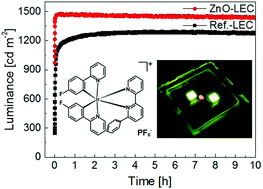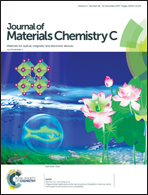Green-yellow emitting hybrid light emitting electrochemical cell†
Abstract
Light-emitting electrochemical cells (LECs) are attractive candidates for future low-cost lighting applications such as light-emitting smart tags, thanks to their simplicity, fully solution-based fabrication and flexibility. However, high brightness and efficiency in combination with satisfactory operation lifetimes need to be achieved for different emission colours bearing future device commercialization in mind. LECs emitting in the yellow-green spectral range, where the human eye is most sensitive are thereby particularly attractive. Here we present an improved hybrid LEC based on an Ir-iTMC, [Ir(4-Fppy)2(pbpy)][PF6] (4-Fppy = 2-(4-fluorophenyl)pyridinato, pbpy = 6-phenyl-2,2′-bipyridine) emitting at 557 nm. It features a luminance of 2400 cd m−2 when driven at a constant voltage of 4 V, and a lifetime of 271 h at a luminance of 1500 cd m−2 under pulsed current operation. The hybrid LEC shows an enhanced performance compared to a LEC solely based on the Ir-ITMC where operation lifetimes of 165 h at a luminance above 1200 cd m−2 under pulsed current operation conditions were observed. The performance improvement was achieved by addition of a solution-processed ZnO nanoparticle film on top.



 Please wait while we load your content...
Please wait while we load your content...